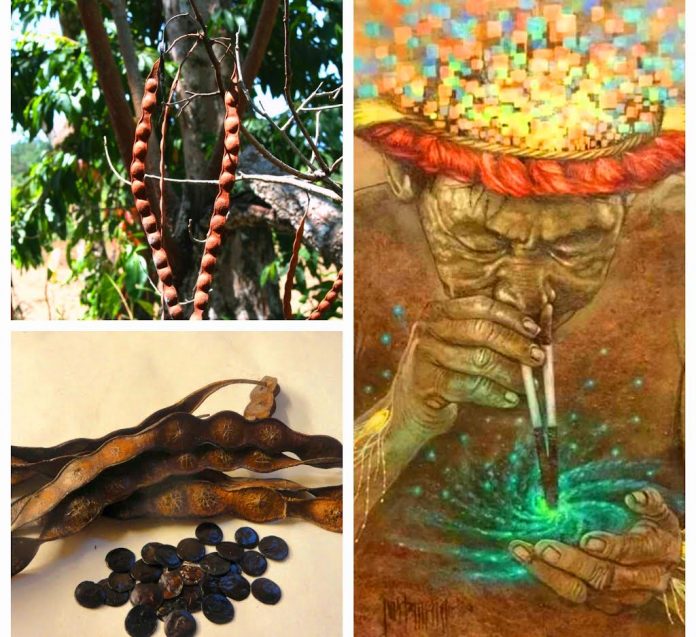Every week, Etnia Nativa writes a new episode about culture and heritage, focusing on native knowledge, transcendental wisdom, and the importance of defending Aruba’s true identity. Its articles connect the reader with the mystical aspects of the island, its culture, and its traditional heritage, encouraging them to interact with the cultural environment and adopt an authentic island state of consciousness.
Today we share details of a plant scientifically called Anadenathera peregrina, commonly known as Yopo, calcium tree, cohoba, parica, or cebil. Through archaeological evidence, we know that its seeds contain a substance that has been used in healing ritual ceremonies for thousands of years.
The seeds of this tree were originally collected from the wild, but increased competition between different Aboriginal tribes for its use caused the plant to be intentionally cultivated and transported to other locations, thus expanding its distribution to areas beyond its original native habitat, which were the Caribbean and other regions of South America.
Science has yet to discover all the positive effects this psychoactive substance has on the body and the mind. However Shamans have experimented with its hallucinogenic powers for millennia.
Yopo is a tree that reaches a height of approximately 20 m (66 ft) tall; its flowers are pale yellow to white spherical clusters resembling Acacia inflorescences; and it’s a plant that somewhat resembles a plant locally known as “Garoti di San Jose”, Leucaena leucocephala; however, the seed pods are completely different.
Native American tribes of the Caribbean, Central America, and South America, including our island ancestral Caquetian’s groups, used to grind the seeds of this mystical plant together with other herbs, snails, or shells, which they cooked over a sacred fire. This mixture was ground after it cooled and then stored in a container or pouch for later use. In this way, they obtained a fine powder, essentially hallucinogenic, that was inhaled or blown into the nose of the participant. This was either a remedy or a spiritual trance. Inhaling is the most effective way of administration as it allows for a larger amount of the plant powder to get in touch with the neuroreceptors, whereas a far less effective way of using yopo is by smoking the seeds of the plant.
The positive psychological and spiritual impacts are the main focus of the yopo’s ceremony. The Shaman guides you so that you avoid slipping into a state of distress by diving too deep into your soul while purifying it from negative energy accumulated through time or stress. It will also bring your mind into a forgotten state in harmony with Mother Earth, which can make your body feel refreshed and revitalized since its medicinal features work for your body’s wellness as well as your spiritual health.
Maybe you can compare the effects of the Yopo to what could resemble the effects of psychotherapy, however mystical in nature. The common experience reported by most consumers is that Yopo helped them improve through introspection and new self-knowledge. Those who practiced or have participated in such ceremonies affirm that Yopo frees your mind from the ties that the person has placed on it themselves and affirm that it intensifies emotional experiences and raises the level of their consciousness; they report major changes in their worldviews, as well as a greater focus on both themselves and their environmental surroundings, both inner and outer existence. Dispositions towards love, serenity, peace, and positive energy are also attributed to the usual experience of participating in a Yopo’s ceremony.
The visions depend on the person consuming the plant, so no hallucinogenic experience is the same. The visionary experiences show that many people can be scared or frightened in the beginning and might reflect suppressed fears and phobias, which can affect the heart rate, increasing palpitations. Yopo ceremony takes you and reveals your deepest fears as well as yearnings and dreams. By seeing and confronting them, you are allowed to manipulate them and revamp them if need be.
Be informed that this is not a promotion or encouragement for you to participate in any shamanic or spiritual ceremonies.
Through the Island Insight platform, we share the most interesting and revealing stories about Aruba as a tourist destination to discover, and if you want to explore the island’s deep heritage, book a visit to Etnia Nativa, a private residence that integrates natural and reused materials and is full of art, culture, and island heritage. Each visitor is guided through an authentic encounter with the owner-builder and cultural expert. WhatsApp +297 592 2702 etnianativa03@gmail.com




















